www.rhci-online.net/radiogram/radiogram.htm
██╗██████╗ ██████╗ ██████╗ █████╗ ██████╗ ██╗ ██████╗ ██████╗ ██████╗ █████╗ ███╗ ███╗
██║██╔══██╗██╔════╝ ██╔══██╗██╔══██╗██╔══██╗██║██╔═══██╗██╔════╝ ██╔══██╗██╔══██╗████╗ ████║
██║██████╔╝██║ ██████╔╝███████║██║ ██║██║██║ ██║██║ ███╗██████╔╝███████║██╔████╔██║
██║██╔══██╗██║ ██╔══██╗██╔══██║██║ ██║██║██║ ██║██║ ██║██╔══██╗██╔══██║██║╚██╔╝██║
██║██████╔╝╚██████╗ ██║ ██║██║ ██║██████╔╝██║╚██████╔╝╚██████╔╝██║ ██║██║ ██║██║ ╚═╝ ██║
╚═╝╚═════╝ ╚═════╝ ╚═╝ ╚═╝╚═╝ ╚═╝╚═════╝ ╚═╝ ╚═════╝ ╚═════╝ ╚═╝ ╚═╝╚═╝ ╚═╝╚═╝ ╚═╝
RSID: <<2016-07-06T20:30Z MFSK-32
@
6070000+1500>>
START START START
QUESTA E' IBC, ITALIAN BROADCASTING CORPORATION
TRASMISSIONI IN ITALIANO
MERCOLEDI' 20-22 UTC 6070 KHZ
VENERDI' 01-01.30 UTC 9955 KHZ
SABATO 01.30-02 UTC 11580 KHZ
website: HTTP://WWW.IBCRADIO.WEBS.COM
email: IBC@EUROPE.COM
"IBC DIGITAL" "IBC DIGITAL" "IBC DIGITAL"
MERCOLEDI' 20.30-21.00 UTC 6070 KHZ
-"RADIOPASSIONI" A CURA DI ANDREA LAWENDEL, IN MFSK 32 (1500 Hz)
-"DX NEWS DX ITALIA", NOTIZIE PER RADIOMATORI TRATTE DAL BOLLETTINO DI I2MQP,
IN OLIVIA 16-500 (2200 Hz)
BUONA DECODIFICA!
"RADIOPASSIONI" "RADIOPASSIONI"
(http://www.radiopassioni.it/)
Webcasting, podcasting e LPFM: luci e ombre di uno spirito della radio più
vitale che mai
L'offerta di contenuti radiofonici originali in streaming è sempre più
abbondante, grazie anche all'aumento del numero di Webradio nate con precisi
obiettivi commerciali, spesso a carattere musicale ispirato a specifici
generi. A queste si aggiungono le stazioni "Internet only" di tipo associativo
e formativo-sperimentale, spesso più orientate alla creazione di format non
necessariamente solo musicali. A questa offerta si aggiungono ovviamente i
canali delle emittenti on air ripetuti anche in streaming, e quelli "extra"
che le stazioni tradizionali, pubbliche o private, diffondono solo in formato
digitale, Web o DAB+. Per non parlare di tutto il mondo dei contenuti
originali e spesso esclusivi accessibili in modalità podcast, una piattaforma
che negli USA, complice il successo di veri e propri hit come Serial (spinoff
da This American Life, programma della NPR) già un anno fa spingeva un
quotidiano come il San Jose Mercury News, ritenuto l'organo ufficiale della
Silicon Valley, a titolare "Perché ci stiamo innamorando dell'ascolto dei
podcast" (http://www.mercurynews.com/bay-area-living/ci_27357158/podcast-
phenomenon-why-were-falling-love-listening).
Sta diventando sempre più solido, insomma, il fenomeno della radio basata su
modelli distributivi non-broadcast, capace cioè di fare a meno di antenne e
frequenze. Per alcuni siamo già arrivati al punto di un potenziale sorpasso,
determinato soprattutto dalla rapida diffusione delle piattaforme di
"connected car", che grazie ai collegamenti 3G/4G portano a bordo
dell'automobile interattività, servizi e una varietà potenzialmente infinita
di contenuti in streaming. In Italia mi vengono in mente, a parte il caso
pionieristico e ormai globale di Spreaker (https://www.spreaker.com/), gli
esempi di giovani imprenditori radio-digitali come Fabrizio Mondo, inventore
con Web Radio Comando prima e oggi con la sua nuova creatura Zeptle
(http://www.zeptle.com/), di un inedito concetto di aggregatore di flussi
radiofonici Web coniugato a un sistema di canalizzazione preso in prestito
dall'LCN della tv digitale terrestre. Zeptle, disponibile su Web e come app, è
una specie di telecomando che permette di accedere alla Webradio preferita
attraverso un codice numerico. Funziona un po' come le tradizionali
piattaforme di aggregazione radiofonica alla TuneIn, ma la fruizione degli
stream è più immediata e il modello di business di Zeptle prevede la
possibilità di vendere all'asta tra le emittenti i numeri di canale più bassi
o facili da memorizzare.
Anche quando consideriamo il problema della saturazione delle frequenze
combinato a una crescita effettivamente troppo lenta dell'alternativa della
radio digitale, c'è da chiedersi se la radiofonia così come la conosciamo oggi
sia destinata a tramontare, magari con gradualità ma in tempi
sorprendentemente rapidi. Il Web si presenta oltretutto come una formidabile
opportunità per i suoi bassi costi di avviamento: tutti o quasi possono fare
radio con investimenti contenuti e minimi requisiti burocratici.
Per come la penso io la radio, diciamo "convenzionale", basata sul modello
broadcast, resta imprescindibile come strumento per la distribuzione di
contenuti audio su bacini di pubblico e territori di una certa ampiezza. La
radio "on air" non richiede terminali utente complessi e non sposta il peso
dei costi di produzione sulle spalle dei suoi ascoltatori, vincolandoli a
sottoscrivere per il loro smartphone un supplemento di tariffa sui piani di
abbonamento base. La mia sensazione è che in un orizzonte temporale di
qualche decennio stiamo andando verso uno scenario radiofonico ancora molto
variegato, in cui broadcast e broadband avranno entrambi un ruolo
determinante. Anche se la tecnologia ci porterà probabilmente a convergere
verso un mondo di radiofonia full ip, in questa fase sarebbe stupido costruire
delle barriere cercando di forzare in un senso o nell'altro l'evoluzione di
questo mezzo. Si deve piuttosto cercare le giuste formule di convivenza.
Queste riflessioni nascono fondamentalmente dalla lettura di alcuni articoli
pubblicati in questi giorni sulla situazione americana, dove questa pluralità
di scenari è già una realtà. Una notizia, riferita da Radiosurvivor
(http://www.radiosurvivor.com/2016/01/05/why-american-independent-internet-
radio-may-go-extinct-in-2016/) e ancora prima da RAINNews
(http://rainnews.com/crb-small-webcasters-face-january-1-with-fear-anger-
hope-and-strategies/), non è per niente positiva per le Webradio americane
indipendenti. Il regime di tariffazione dei brani musicali diffusi in stream
su Internet concordato nel 2006 con il Copyright Royalty Board è scaduto lo
scorso dicembre e le nuove tariffe in vigore dal 1 gennaio non tengono conto,
secondo le due testate specializzate, della speciale convenzione che il CRB
aveva raggiunto nel 2009 con gli Internet broadcaster di piccole dimensioni,
che finora hanno goduto di un regime speciale. Per ogni brano trasmesso,
scrivono Brad Hill e Paul Riismandel, le Webradio "indie" oggi saranno
costrette a pagare somme dieci, quindici volte superiori. A fronte di un
aumento dei costi così ingenti, sarà veramente dura andare avanti, sia per la
stazioni che si mantengono vendendo pubblicità, sia per chi ha scelto invece
formule di subscription o altri sostegni da parte degli ascoltatori. Le
speranze del settore di questi piccoli Webcaster sarebbero ormai riposte in
SoundExchange (http://www.soundexchange.com/), la società che raccoglie le
royalties per conto delle case discografiche, con cui gli editori indipendenti
potrebbero studiare accordi alternativi.
Se i Webcaster non legati alle grandi piattaforme streaming sono preoccupati,
anche i podcaster americani non riescono a godersi pienamente il momento di
grande visibilità della loro programmazione "asincrona". Il problema in questo
caso non è tanto legato ai costi di trasmissione, quanto piuttosto alla
sostenibilità delle revenues pubblicitarie e da una relazione tra produttori
dei contenuti e sponsor improntati a modelli vecchi di un secolo. I podcast,
scrive Fastcompany (http://www.fastcompany.com/3054877/most-creative-
people/beyond-mail-kimp-the-future-of-podcast-advertising), hanno un
grandissimo successo ma faticano a sfruttare questa popolarità perché usano la
pubblicità come avrebbero fatto le soap opera degli anni Cinquanta. Il
podcasting, forse il simbolo più conosciuto di una radiofonia completamente
"nuova", vive insomma il paradosso di ricorrere, in un mondo di metriche e
analisi demografiche avanzatissimi, all'«and now a word from our sponsor» di
settanta anni fa, con gli autori dei podcast che leggono gli annunci prima di
cominciare. La rivista dedicata all'innovazione nel business propone di
rivoluzionare questo approccio prendendo come esempio il caso di Acast
(http://www.acast.com/), una startup che dopo aver aperto i battenti in Svezia
ha prima creato un ufficio a Londra per poi varcare l'Atlantico e concentrare
la sua azione sulla patria del podcasting.
«La strategia di Acast si muove su tre fronti - scrive Melissa Locker: aiutare
gli ascoltatori a individuare nuovi podcast [attraverso una accurata selezione
effettuata da redattori umani, NdR], abilitare i produttori nuovi entranti e
quelli più consolidati a distribuire più efficacemente i loro podcast e
assistere gli inserzionisti a sfruttare meglio il potenziale di un mercato in
crescita facendo leva su metriche di miglior qualità su una targetizzazione
più precisa.»
Karl Rosander e Måns Ulvestam, i due fondatori di Acast puntano a costruire
uno Spotify del podcasting, cercando soprattutto di coinvolgere, con la loro
piattaforma e l'inevitabile app, i grandissimi sponsor. Negli Stati Uniti
hanno già messo insieme un pool di competenze che include due esperti dal
mondo della National Public Radio newyorkese e hanno stipulato accordi con
portali come BuzzFeed.
Mentre Webradio e podcasting vivono una contraddittoria fase di luci e ombre,
segnali incoraggianti giungono secondo Rob Pegoraro di Yahoo! Tech proprio dal
mondo della cara vecchia radio FM, un settore in cui la legge voluta dalla FCC
dell'era Obama, il Local Community Radio Act del 2010, ha aperto la strada a
stazioni a bassissima potenza che riescono a convivere serenamente anche
occupando frequenze vicine alle stazioni più grandi, titolari di licenze
commerciali convenzionali. Citando come fonte lo stesso Radiosurvivor
(http://www.radiosurvivor.com/category/noncommercial-radio-2/community-
radio/lpfm/), Pegoraro loda stazioni come WERA (http://wera.fm/) di Arlington,
Virginia, lanciata il 6 dicembre scorso da Arlington Independent Media
(https://www.arlingtonmedia.org/projects/about-wera-967-lp-fm) - una
organizzazione no profit che promuove la cultura e la tecnica dei media
indipendenti - che con i suoi 21 watt riesce comunque a coprire parte della
città di Washington D.C. Ancora Paul Riismandel su Radiosurvivor
(http://www.radiosurvivor.com/2016/01/07/2015-in-review-lpfm-made-it-
community-radios-biggest-leap-forward/) afferma che il 2015 è stata una
grandissima annata per le stazioni LPFM, con oltre 520 nuove licenze. Una
crescita quasi del 70% superiore rispetto agli andamenti registrati fino al
2013, la prima finestra aperta dalla FCC per la concessione di questi speciali
permessi di trasmissione. «A quanto ne so non esiste un preciso censimento
delle community station americane - scrive Riismandel, ma nei 25 anni che ho
trascorso studiando questo settore radiofonico non ho mai registrato un anno
con una analoga crescita.» I due esperti concludono che lo spirito della radio
libera è ancora in ottima salute, anche negli affollati spazi dell'FM.
END
"RADIOPASSIONI" "RADIOPASSIONI" "RADIOPASSIONI"
( http://www.radiopassioni.it/ )
"IBC DIGITAL" "IBC DIGITAL"
SWITCH NOW TO OLIVIA 16-500(2200 Hz)
RSID: <<2016-07-06T20:46Z
OL 16-500 @
6070000+2200>>
START START
"IBC DIGITAL" "IBC DIGITAL"
"DX NEWS DX ITALIA" "DX NEWS DX ITALIA"
FUTURE OPERATIONS --- OPERAZIONI FUTURE
CE Chile Nov 14 - Nov 11
XR5M group will be on from SA-061 CE6CT
CE0Y Easter Isl. Oct 24 - Dec 2 RZ3FW and R4WAA as CE0Y/ qsl H.C.
CY St. Paul Aug 19 - Aug 29
CY9C 11 operators qsl WA4DAN OQRS
D6 Comoros Sep 18 - Oct 1 OK1FPS, OK1FCJ aOK6DJ as D66D qsl OK6DJ Clublog
DL Germany Jul 28 - Aug 1 DR0F from EU-1 Bur
DL Germany Jul 20 - Jul 31 DG5LAC as /p from EU-042 qsl H.C. OQRS
EA6 Balearic Jul 30 - Jul 31 M0DXR as /EA6 qsl H.C. dir & bur
EA8 Canary Islands Jul 11 - Jul 25 IW2NEF
as /EA8 qsl IK2DUW
EA9 Ceuta & Melilla Jul 16 - Jul 17 EC7DZZ & EA7FKH as EG9LH qsl EC7DZZ
F France Jul 30 - Jul 31 TM6G contest from EU-048 ON6DP qsl dir
FM Martiniwue Oct 29 - Nov 4 AA4OC, N7BF, WT4BT and W6ABM as /FM qsl H.C. LoTW
ClubLog
FO F.Polynesia Aug 17 - Aug 28 DL2AH from OC-063 as TX2AH qsl H.C.
FP S. Pierre Sep 10 - Sep 20 TO5FP from NA-032 qsl FT4X
G England Jul 30 - Jul 31 G6LD from EU-120
GD Isle of Man Jul 30 - Jul 31 MD7C contest by M5RIC from EU-116 qsl M0OXO
GM Scotland Jul 30 - Jul 31 GM0ADX contest from EU-008 qsl H.C.
GM Scotland Jul 30 - Jul 31 MM0GOR from EU-009 as MM1E qsl H.C. & LoTW
H44 & H40 Solomon & Temotu Sep 24 - Oct 21
LZ1GC as H44GC & H40GC. DL8JJ will join him as H44GC till Oct 3. Will then be active as H40GC from OC-100 qsl
H.C. Club Log LoTW
END END
"DX NEWS DX ITALIA" "DX NEWS DX ITALIA"
"IBC DIGITAL" "IBC DIGITAL"
END END
██████╗ ██╗ ██████╗ ██╗ ██████╗ ██╗ ██╗
██╔══██╗██║██╔════╝ ██║ ██╔══██╗╚██╗██╔╝
██║ ██║██║██║ ███╗██║ ██║ ██║ ╚███╔╝
██║ ██║██║██║ ██║██║ ██║ ██║ ██╔██╗
██████╔╝██║╚██████╔╝██║ ██████╔╝██╔╝ ██╗
╚═════╝ ╚═╝ ╚═════╝ ╚═╝ ╚═════╝ ╚═╝ ╚═╝
RSID: <<2016-07-03T21:30Z
MFSK-32 @ 1
5770000+1500>>
Hello and welcome to DigiDX 19 , a weekly review of the latest shortwave
and DX news broadcast mainly in MFSK32 mode. This broadcast includes
shortwave news, an article on Nazi Radio Propaganda in Latvia from
1941-1945 and the over-the-air QSL card.
After 3 minutes on 2350 Hz we will have a shorter version of this
episode in Olivia 8-250 mode. Please record the episode or use multiple
instances of your decoding software to decode this extra stream.
DigiDX weekly schedule:
Sunday 2130 - 15770kHz via WRMI (Okeechobee, FL, USA)
Sunday 2330 - 11580kHz via WRMI (Okeechobee, FL, USA)
Monday 2000 - 6070kHz via Channel 292 (Rohrbach Wall, DE)
Daily 0530/1830 - 6070kHz via Channel 292 (Rohrbach Wall, DE)
Thanks to Channel 292 broadcasting the extra daily repeats of DigiDX, to
buy shortwave time from Channel 292 at very reasonable prices go to
http://www.channel292.de.
Any other extra broadcasts will be listed on http://www.digidx.uk
If you enjoy DigiDX and find the service useful please consider donating
via Paypal to reports@digidx.uk
or via our Patreon page. Any money
donated will go towards paying for airtime to keep DigiDX on the air to
Europe and North America.
Every donation will help no matter how little
-https://www.patreon.com/digidx.
/ reports@digidx.uk
Thanks very much to listeners Oscar Marazzini, Alan Gale, Jordan
Heyburn, Fred Albertson, Mike Stapp, Mark Braunstein and Richard Langley
for contributing via Paypal or to the Patreon campaign.
Sorry for the lack of a DigiDX episode last weekend, this was due to an
operation I had and was still in recovery from and therefore unable to
create a new DigiDX. Thanks to Kim Andrew Elliott for allowing me to
broadcast VOA Radiogram instead. This operation is also the reason I
have recently been slow replying to emails and reception reports for
DigiDX.
Latest Shortwave News:
RNZI to change to one transmitter schedule
PCJ Radio Special broadcast
New Managing Director of ABC signals a return to international broadcasting
Radio Liberty ends Russian shortwave broadcasts
SDRUno Released for SDRPlay
WRTH updates A16 schedule
Radio Niger Delta, Voice Of Peace begins transmission from July 1
RNZI to change to one transmitter schedule
Radio New Zealand International have announced that they will stop using
one of their 2 shortwave transmitters and move to a one transmitter
operation.
The transmitter being retired is a 27 year old analogue only transmitter
and the current transmitter used for DRM broadcasts will now be used for
both AM and DRM modes. This means that there will no longer be a 24 hour
analogue service as AM mode will be off air when the transmitter is
being used for DRM.
The DRM service is mainly used for feeding broadcasts of RNZI to FM
relay stations on isolated Pacific islands, RNZI has said it is looking
at ways to replace DRM for feeding these relays and in future it may be
able to put some of this capacity back into analogue shortwave
transmissions.
The new schedule will be as follows (via Glenn Hauser, DXLD):
UTC kHz Target Days
0000-0458 15720 (AM) Pacific Daily
0459-0658 11725 (AM) Pacific Daily
0659-1058 9700 (AM) Pacific Daily
1059-1258 9700 (AM) PNG Daily
1259-1650 6170 (AM) Pacific Daily
1651-1858 7330 (AM) Pacific Sat
1651-1850 5975 (DRM) Cook Islands, Tonga, Samoa Sun-Fri
1850-1950 9760 (DRM) Cook Islands, Tonga, Samoa Sun-Fri
1859-1958 9700 (AM) Pacific Sat
1951-2050 11690 (DRM) Pacific Sun-Fri
1959-2058 11725 (AM) Pacific Sat
2051-0000 15720 (AM) Pacific Daily
|
PCJ Radio Special broadcast
On the 18th of July PCJ Radio International will present a special two
hour program called From the Radio Netherlands Archives.
The special program will broadcast material from the Radio Netherlands
archives that has not been heard since it was originally broadcast.
Material will be from 1947 to 1995 and will include some rare material.
Rare material will be from Jerry Cowan, Dody Cowan, Harry van Gelder,
Eddie Startz, Tom Meijer and many others. Also included will be rare
performances recorded at the wereldomroep of some internationally known
artists.
The program will be presented by Paulette MacQuarrie; producer, editing
will be Keith Perron who will also do the prologue. This will be the
first of a number of specials. PCJ Radio have also promised that
listeners who write in will also get a special e-QSL.
North America: 0100 to 0300UTC – Frequency 7570kHz
Europe: 0600 to 0800UTC – Frequency 7780kHz
Both transmissions will be via WRMI in Okeechobee, Florida.
|
http://www.pcjmedia.com/
EUROPE
July 17, 2016
Frequency: 7780kHz
Time: 0600 - 0800 UTC
NORTH AMERICA
July 18, 2016
Frequency: 7570kHz
Time: 0100 - 0300 UTC
|
|
|
|
http://jonathanmarks.libsyn.com/rss |
New Managing Director of ABC signals a return to international
broadcasting
The Australian Saturday Paper has published an interesting snippet of
information about the new director of the Australian Broadcasting
Corporation, Michelle Guthrie.
Article author Hamish McDonald writes:
We are told she also “forcefully expressed” her interest in the
corporation returning to full-blooded international broadcasting, and
raised the fact that Radio Australia no longer broadcasts in Mandarin,
nor in Tok Pisin, the lingua franca of Papua New Guinea. A return to
international TV broadcasting two years after the Abbott government
scrapped funding for the ABC’s Australia Network (to please Rupert
Murdoch) would not come cheap. Nor would a revival of Radio Australia,
once the major arm of Australia’s soft power in the region.”
Radio Liberty ends Russian shortwave broadcasts
As previously announced Radio Liberty ended it’s broadcasts in Russian
on the 26th June 2016. The only Radio Liberty / Radio Free Europe
broadcasts remaining on shortwave are in Dari, Tajik, Uzbek, Avar,
Turkman and Pasto.
Broadcasts in Russian continue on medium wave via Lithuania via a
transmitter broadcasting at 75kW but this will soon be replaced by a new
200kW solid state MW transmitter.
SDRUno Released for SDRPlay
The SDRUno software which is a modified version of the Studio1 software
has now been released for the popular SDRPlay SDR. In a surprise to most
people the software has been made available for free and is fully
featured on the SDRPlay and provides limited functionality (e.g.
bandwidth limit and no notch filters) on other SDR’s via an ExtIO .dll
file.
SDRPlay have said that support for other SDR software such as HDSDR, SDR
Console and Cubic SDR will continue despite the release of SDRUno.
Webinars will also be run by SDRPlay to provide help and information
about SDRUno. The first event wasscheduled for Saturday 2nd July and
gave some background to SDRuno, explained it's core functionality and
what the future holds for its development.
The Webinar can be viewed via http://connectcast.tv/SDRplay or to get
the SDRUno software or buy an SDRPlay go to
http://www.sdrplay.com/7
===>
http://www.sdrplay.com/purchase.php
WRTH updates A16 schedule
The World Radio TV Handbook have released an updated PDF version of
their A16 schedule including the changes at RNZI, Radio Liberty and
other broadcasters. To get this PDF update for free (with a suggested
donation of £5) go to
http://www.wrth.com/_shop/?page_id=444.
Radio Niger Delta, Voice Of Peace begins transmission from July 1
A new clandestine station Radio Niger Delta, Voice Of Peace has begun
twice daily transmissions on shortwave from the 1st of July. The
broadcast is created in New York by some members of the Nigerian
diaspora.
Nigerian site IGBereTV has reported that the morning transmission was
“received with clear signals in Lagos, Port Harcourt, Brass, Warri,
Yenagoa, Sokoto, Niamey and Abidjan” The transmission is believed to
be from Issoudun, France and has the following schedule:
0500-0555 on 9515kHz
1900-1955 on 11985kHz
Upcoming relays and special broadcasts:
VOA Radiogram will be on air this weekend on the following frequencies,
for more information on the modes to be used visit
http://voaradiogram.net/
Sat 0930-1000 5745 kHz
Sat 1600-1630 17580 kHz
Sun 0230-0300 5745 kHz
Sun 1930-2000 15670 kHz
All broadcasts are from Greenville, NC.
IBC - Italian Broadcasting Corporation has added a digital mode
broadcast to weekly broadcast via Channel 292 on 6070kHz.
The entire broadcast is Wednesday 2000 to 2200 UTC, with MFSK32 followed
by Olivia 16-500 at 2030-2100 UTC. The text includes DX and amateur
radio news.
Now follows an article by Māris Goldmanis from latvianhistory.com on
Nazi Radio Propaganda in Latvia 1941-1945.
The head of the Nazi propaganda Joseph Goebbels recognized radio as the
most advanced tool of propaganda. At the age of the printed press,
posters and leaflets radio was truly the most modern way of political
communication. During the interwar period the radio broadcasting became
more advanced and radio stations were established all around Europe. The
Latvia got its first official radio station in 1924. Radio became fairly
popular in Latvia before the World War II. In 1939 the Latvian Radio had
154 400 subscribers. Latvian main industrial company the VEF produced
modern radio receivers. Also many radios were imported from Germany.
Before the WWII the main frequency range was the longwave (150-375 kHz)
and the mediumwave (AM) (535-1600 kHz). However already in the late
twenties broadcasters started to use shortwave band (1600-2900 kHz) that
allowed to send signals in more further areas. With usual pre-war
receiver Latvians could tune to stations from Germany, Great Britain and
Soviet Union. After the Soviet occupation in 1940, the registration of
radio receivers begun and many people had their radios confiscated. Not
only because of the possibility of receiving “rouge” situations, but
also because the ownership of radio receiver indicated that the owner
belongs to bourgeois class.
At the very beginning of the German invasion on June 22 1941, German
radio station called “Vineta” located in Konigsberg (Kaliningrad)
started broadcasting in Latvian language. Radio transmitted the German
declaration of war and Hitler’s address to the German nation. Germans
understood the importance of broadcasting their propaganda in Latvian
maiden language. The listener is always more positive to information in
his own language. Radio issued calls to Latvians not to resist the
Germans and not to support the Soviets.
On July 1 as the Red Army was retreating away from Riga, the non-soviet
Latvian Radio begun its work. An hour before the German soldiers
appeared the director of company “Latvian Films”, Albets Jekste took
over the main radio building. He did this with the consent of the German
colonel Walter Ulersperger also the commandant of Riga. The radio
broadcast begun at 10:00 with the opening speech by colonel Ulerspeger
who declared that Riga was liberated and ended his speech in Latvian by
saying “God Bless Latvia!” After that the Latvian anthem was played
followed by Jekste announcement. The announcement was “Greet the
German soldiers with jubilant gratitude and give a helping hand
everywhere you can! Because once and for all the end has come to
communism and Jewry in Latvia!” The slogans of the Riga radio
broadcasts were completely adjusted to the needs of the Nazi propaganda.
There is a myth that during the first days during the Nazi occupation
Latvians had time for their self action against the Soviets and Jews.
However, the transcripts of the Riga radio broadcasts shows that the
Latvian “free action” did not last for a second. Everything was
under according to German instructions. Latvian radio just as press
sparked large anti-Semitic propaganda.
On October 1941 the Riga Radio was included in the Reich Radio Structure
RRG (Reichs Rudfunk GmbH”. The Ostland (the official name of German
occupied Baltic States) radio group was made. The Alberts Jekste was
replaced with Hans Kreigler who took charge of all transmitters within
the Baltic states. Latvia had radio transmitters in Riga, Madona,
Kuldīga and Leipāja. The board of the radio was replaced entirely by
Germans. Latvians kept their jobs but was under German command.
The Ostand radio had following orders: fight the British and Bolshevik
propaganda, show British as traitors and reveal the Bolsheviks as the
main enemies of the Baltic people. Also show the Jews as the main
initiators of the war and financiers of the Allies. The Germans were to
be portrayed as the saviors of the Baltic nations. Radio also issued
provisions and orders. Positive information about Germany and
introduction about the Nazi ideas was also included. Commentaries about
world issues and military events followed. All materials came from the
main German Bureau of information (DNB). Nothing else could be
broadcasted. The German sent materials were translated into Latvian.
Local news was taken from Nazi approved newspapers. There were also
cultural programs playing music or reading poems. The Latvian radio
program broadcasted usually for 15-20 hours and was filled with music.
However, those who owned the receivers could still tune to the enemy
broadcasts. BBC World Service had a transmitter in Sweden and Radio
Moscow could reach Latvia. German propaganda called Latvians not to
listen to the Jewish propaganda that only causes chaos and
misunderstanding. The Radio Ostland was enough and listening to the
German radio was the sign of loyalty of the Eastern nations. When that
was not enough a punishment to the “irresponsible” listeners were
issued. A punishment was arrest and radio confiscation or even death
sentence.
German authorities were worried that many Latvians are listening to the
Radio Moscow. Others tuned to the BBC World Service. There was a case
when two Latvian workers living next door to the German soldiers were
caught listening to the Radio Moscow. They were listening the radio too
load and alerted the Germans. To curb the enemy broadcast listening
rumors about special radio direction devices were spread. People were
warned that their radio receivers will be located when tuning to
restricted frequencies. However, there were no such devices and most
people was reported by their neighbors and colleagues. Even today the
radio direction is mostly experimental.
German authorities constantly monitored the enemy broadcasts. On 1944
German authorities were alerted by the fact that clandestine broadcast
called “Soltadensender Calais” (Calais Soldiers Station) can be
received in the Baltic area. This station was made by the British to
demoralize German soldiers. As the hopes of German victory became even
weaker more and more reports were made about listening the allied
broadcasts. Germans constantly criticized the propaganda made by the BBC
and Radio Moscow. But people were tired of German propaganda. Some were
tuning to BBC World Service to hear the news of the coming allied
landing on the coast of the Baltic sea. Others listened Radio Moscow to
know how close is Soviets to Latvia. Many were just curious and wanted
to know different opinions on what is happening.
German radio propaganda in the end proved ineffective. Radio receivers
were not widespread. Most people relied on newspapers. Another factor
that German radio propaganda was targeted more for the Germans rather
than Latvians. Most air time was just rebroadcasts from Berlin and
targeted for soldiers. Latvian listeners received little attention. Most
local information was about the local economy and everyday issues. So it
was no wonder why people tried to listen to allied broadcasts.
On October 12 1944 Soviet Army approached Riga. The Germans destroyed
the radio transmitter tower and evacuated the radio station. The last
German radio station was located in Liepaja and was called “Hallo
Liepaja!”. After the radio tower was destroyed in Kuldīga, the German
radio was receivable at very small distances around Liepāja. The German
radio ceased its broadcasts on May 7 1945. After this Latvia entered a
new age of radio broadcasting where Nazi propaganda was changed with the
Soviet propaganda. And once again occupants had to find ways to silence
the radio broadcasts from abroad.
Selected Sources:
Zellis, Kaspars (2012) “Ilūziju un baiļu mašinērija. Propaganda
nacistu okupētajā Latvijā: vara, mediji un sabiedrība
(1941‒1945)” Riga. Mansards.
Now follows two E-QSL cards. On 1500Hz in MFSK32 we have the QSL card
for reception reports received for the broadcast on 19th and 20th of
June and on 2200Hz in MFSK16 mode there is a special e-QSL for people
who emailed reports@digidx.uk
with a report for the re-broadcast of VOA
Radiogram on the 26th and 27th June.
Due to a mistake a Channel 292 the re-broadcast of VOA Radiogram last
week was actually on at 1930 instead of the normally scheduled 2000UTC
slot, hopefully DigiDX will be back at 2000 this Monday.
Also please remember the extra broadcasts via Channel 292 at 0530 and
1830 every day, this has recently been a special different version of
DigiDX testing various other digital modes put together by listener
Merkouris.
Sending Pic:466x266;
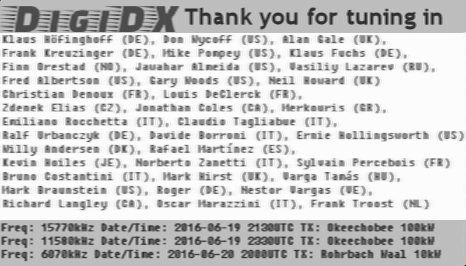
NO RSID
<<2016-07-03T21:56Z
MFSK-16
@ 1577000+2200>>
Sending Pic:466x266;
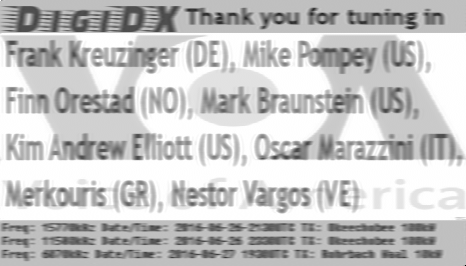
RSID: <<2016-07-03T21:58Z
MFSK-32 @ 6070000+1500>>
Thank you for listening, please send reports, comments and shortwave related
news or articles to reports@digidx.uk.
This is DigiDX Signing off.....
RSID: <<2016-07-06T18:30Z
MFSK-32 @
6070000+1500>>
Hello and welcome to the
experimental version of DigiDX 19,
a weekly review of the latest shortwave and DX news. This broadcast includes
some observations on the S/N ratio performed during the extra broadcasts of
DigiDX 18, shortwave news, and the over-the-air QSL
card.
DigiDX weekly schedule:
Sunday 2130 – 15770 kHz via WRMI (Okeechobee, FL, USA)
Sunday 2330 – 11580 kHz via WRMI (Okeechobee, FL, USA)
Monday 2000 – 6070 kHz via Channel 292 (Rohrbach
Wall, DE)
Daily 0530/1830 - 6070 kHz via Channel 292 (Rohrbach Wall, DE)
Any other extra broadcasts will be listed on
http://www.digidx.uk
--- DigiDX 18 SNR OBSERVATIONS ---
Here follows some observations on the S/N ratio reported by Fldigi, performed in
Thessaloniki, Greece during the extra broadcasts of the experimental version of
DigiDX #18, via Channel 292 on 6070 kHz at 1830 UTC.
+---------+--------------------------+--------------------------+
| |
Olivia 8-500 only
| Olivia 8-500 w/ MFSK16
|
| SNR[dB] +--------+--------+--------+--------+--------+--------+
| |
Low |
High |Midrange| Low
| High |Midrange|
+---------+--------+--------+--------+--------+--------+--------+
| June 23 | -2.5 |
+10.5 | +4.0
| -17.6 | +7.5
| -5.1 |
| June 24 | -8.5 |
+7.8 | -0.4
| -11.3 | +6.8
| -2.3 |
| June 25 | -12.7 | +9.8
| -1.5
| -12.1 | +8.9
| -1.6 |
| June 26 | -7.9 |
+9.9 | +1.0
| -12.5 | +4.8
| -3.9 |
+---------+--------+--------+--------+--------+--------+--------+
| Average | -7.9 |
+9.5 | +0.8
| -13.4 |
+7.0 | -3.2
|
+---------+--------+--------+--------+--------+--------+--------+
On average, fldigi reported 4.0 dB higher SNR when Olivia 8-500 was the only
broadcast.
+---------+--------------------------+--------------------------+
| |
MFSK16 only |
MFSK16 w/ Olivia 8-500 |
| SNR[dB] +--------+--------+--------+--------+--------+--------+
| |
Low | High
|Midrange| Low
| High
|Midrange|
+---------+--------+--------+--------+--------+--------+--------+
| June 23 | -4.0 |
+1.0 | -1.5
| -7.0 |
+1.0 | -3.0
|
| June 24 | -6.0 |
+9.0 | +1.5
| -9.0 |
-1.0 | -5.0
|
| June 25 | -2.0 |
+5.0 | +1.5
| -5.0 |
+3.0 | -1.0
|
| June 26 | -1.0 |
+8.0 | +3.5
| -6.0 |
+4.0 | -1.0
|
+---------+--------+--------+--------+--------+--------+--------+
| Average | -3.3 |
+5.8 | +1.3
| -6.8 |
+1.8 | -2.5
|
+---------+--------+--------+--------+--------+--------+--------+
On average, fldigi reported 3.8 dB higher SNR when MFSK16 was the only
broadcast.
Although the above results are not, by any means, the product of a scientific
research, the trend is obvious: The SNR decreases when multiple modes share the
spectrum. As a result, this drop in the SNR may prove crucial for a successful
decoding of the digital
modes. Safer conclusions would have been drawn if fldigi kept a log file of the
SNR at fixed time intervals.
Please send your reception reports, comments or suggestions to reports@digidx.uk.
If you enjoy DigiDX and find the service useful please consider donating via
Paypal to reports@digidx.uk or via our Patreon page. Any money donated will go
towards paying for airtime to keep DigiDX on the air to Europe and North
America.
Every donation will help no matter how little
-https://www.patreon.com/digidx. /
reports@digidx.uk
Now DigiDX changes to MFSK16 at 2250 Hz.
Please set the mode and centre frequency manually.
RSID: <<2016-07-03T18:36Z
MFSK-16
@ 6070000+2250>>
... This is DigiDX in MFSk16.
--- LATEST SHORTWAVE NEWS ---
RNZI to change to one transmitter schedule
Radio New Zealand International have announced that they will stop using one of
their 2 shortwave transmitters and move to a one transmitter operation.
The transmitter being retired is a 27 year old analogue only transmitter and the
current transmitter used for DRM broadcasts will now be used for both AM and DRM
modes. This means that there will no longer be a 24 hour analogue service as AM
mode will be off air
when the transmitter is being used for DRM.
The DRM service is mainly used for feeding broadcasts of RNZI to FM relay
stations on isolated Pacific islands, RNZI has said it is looking at ways to
replace DRM for feeding these relays and in future it may be able to put some of
this capacity back into analogue
shortwave transmissions.
The new schedule will be as follows (via Glenn Hauser, DXLD):
UTC kHz
Target
Days
0000-0458 15720 (AM) Pacific
Daily
0459-0658 11725 (AM) Pacific
Daily
0659-1058 9700 (AM)
Pacific
Daily
1059-1258 9700 (AM)
PNG
Daily
1259-1650 6170 (AM)
Pacific
Daily
1651-1858 7330 (AM)
Pacific
Sat
1651-1850 5975 (DRM) Cook
Islands, Tonga, Samoa Sun-Fri
1850-1950 9760 (DRM) Cook
Islands, Tonga, Samoa Sun-Fri
1859-1958 9700 (AM)
Pacific
Sat
1951-2050 11690 (DRM) Pacific
Sun-Fri
1959-2058 11725 (AM) Pacific
Sat
2051-0000 15720 (AM) Pacific
Daily
PCJ Radio Special broadcast
On the 18th of July PCJ Radio International will present a special two hour
program called From the Radio Netherlands Archives.
The special program will broadcast material from the Radio Netherlands archives
that has not been heard since it was originally broadcast. Material will be from
1947 to 1995 and will include some rare material.
The program will be presented by Paulette MacQuarrie; producer, editing will be
Keith Perron who will also do the prologue. This will be the first of a number
of specials. PCJ Radio have also promised that listeners who write in will also
get a special e-QSL.
North America: 0100-0300 UTC on 7570 kHz
Europe: 0600-0800 UTC on 7780 kHz
Both transmissions will be via WRMI in Okeechobee, FL.
New Managing Director of ABC signals a return to international broadcasting
The Australian Saturday Paper has published an interesting snippet of
information about the new director of the Australian Broadcasting Corporation,
Michelle Guthrie.
Article author Hamish McDonald writes:
We are told she also “forcefully expressed” her interest in the corporation
returning to full-blooded international broadcasting, and raised the fact that
Radio Australia no longer broadcasts in Mandarin, nor in Tok Pisin, the lingua
franca of Papua New Guinea. A
return to international TV broadcasting two years after the Abbott government
scrapped funding for the ABC’s Australia Network (to please Rupert Murdoch)
would not come cheap. Nor would a revival of Radio Australia, once the major arm
of Australia’s soft power in
the region.”
Radio Liberty ends Russian shortwave broadcasts
As previously announced Radio Liberty ended its broadcasts in Russian on the
26th June 2016. The only Radio Liberty / Radio Free Europe broadcasts remaining
on SW are in Dari, Tajik, Uzbek, Avar, Turkman and Pasto.
Broadcasts in Russian continue on MW via Lithuania via a transmitter
broadcasting at 75kW but this will soon be replaced by a new 200kW solid state
MW transmitter.
SDRUno Released for SDRPlay
The SDRUno software which is a modified version of the Studio1 software has now
been released for the popular SDRPlay SDR. In a surprise to most people the
software has been made available for free and is fully featured on the SDRPlay
and provides limited functiona
lity (e.g. bandwidth limit and no notch filters) on other SDRs via an ExtIO .dll
file.
SDRPlay have said that support for other SDR software such as HDSDR, SDR Console
and Cubic SDR will continue despite the release of SDRUno. Webinars will also be
run by SDRPlay to provide help and information about SDRUno. The first event was
scheduled for Saturday
2nd July and gave some background to SDRuno, explained its core functionality
and what the future holds for its development.
The Webinar can be viewed via
http://connectcast.tv/SDRplay or to get the SDRUno
software or buy an SDRPlay go to
http://www.sdrplay.com/7
WRTH updates A16 schedule
The World Radio TV Handbook have released an updated PDF version of their A16
schedule including the changes at RNZI, Radio Liberty and other broadcasters. To
get this PDF update for free (with a suggested donation of £5) go to
http://www.wrth.com/_shop/?page_id=444.
Radio Niger Delta, Voice Of Peace begins transmission from
July 1
A new clandestine station Radio Niger Delta, Voice Of Peace has begun twice
daily transmissions on shortwave from the 1st of July. The broadcast is created
in New York by some members of the Nigerian diaspora.
Nigerian site IGBereTV has reported that the morning transmission was “received
with clear signals in Lagos, Port Harcourt, Brass, Warri, Yenagoa, Sokoto,
Niamey and Abidjan” The transmission is believed to be from Issoudun, France and
has the following schedule:
0500-0555 on 9515 kHz
1900-1955 on 11985 kHz
--- UPCOMING RELAYS AND SPECIAL BROADCASTS ---
VOA Radiogram will be on air this weekend on the following frequencies, for more
information on the modes to be used visit http://voaradiogram.net/
Sat 0930-1000 5745 kHz
Sat 1600-1630 17580 kHz
Sun 0230-0300 5745 kHz
Sun 1930-2000 15670 kHz
All broadcasts are from Greenville, NC.
IBC - Italian Broadcasting Corporation has added a digital mode broadcast to
weekly broadcast via Channel 292 on 6070 kHz.
The entire broadcast is Wednesday 2000 to 2200 UTC, with MFSK32 followed by
Olivia 16-500 at 2030-2100 UTC.
Now follows two e-QSL cards. The first one is for reception reports received for
the broadcast on 19th and 20th of June and the second one is a special e-QSL for
people who emailed reports@digidx.uk with a report for the re-broadcast of VOA
Radiogram on the 26th
and 27th June. Both will be transmitted
in MFSK32 in double speed, using the X2 fldigi specific image mode.
RSID: <<2016-07-03T18:55Z
MFSK-32
@ 6070000+2250>>
This is DigiDX in MFSK32 ...
Sending Pic:525x300p4;
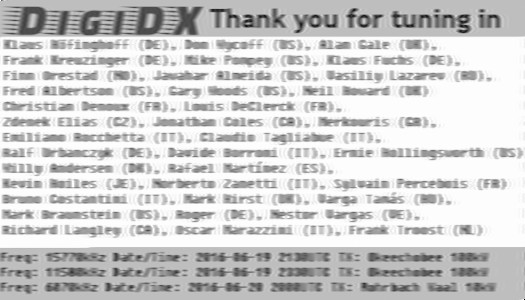
Sending Pic:525x300p4;
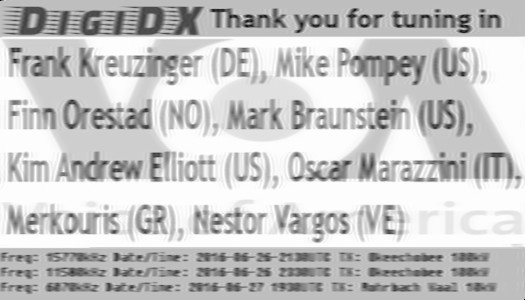
Thanks to Channel 292 broadcasting the extra daily repeats of DigiDX, to buy
shortwave time from Channel 292 at very reasonable prices go to
http://www.channel292.de.
Please send any reception reports, comments, radio reviews or suggested stories
to reports@digidx.uk
This is DigiDX signing-off...
██╗ ██╗██████╗ ██████╗ ██████╗ █████╗ ██████╗ ██╗ ██████╗ ██████╗ ██████╗ █████╗ ███╗ ███╗
██║ ██╔╝██╔══██╗██╔════╝ ██╔══██╗██╔══██╗██╔══██╗██║██╔═══██╗██╔════╝ ██╔══██╗██╔══██╗████╗ ████║
█████╔╝ ██████╔╝██║ ██████╔╝███████║██║ ██║██║██║ ██║██║ ███╗██████╔╝███████║██╔████╔██║
██╔═██╗ ██╔══██╗██║ ██╔══██╗██╔══██║██║ ██║██║██║ ██║██║ ██║██╔══██╗██╔══██║██║╚██╔╝██║
██║ ██╗██████╔╝╚██████╗ ██║ ██║██║ ██║██████╔╝██║╚██████╔╝╚██████╔╝██║ ██║██║ ██║██║ ╚═╝ ██║
╚═╝ ╚═╝╚═════╝ ╚═════╝ ╚═╝ ╚═╝╚═╝ ╚═╝╚═════╝ ╚═╝ ╚═════╝ ╚═════╝ ╚═╝ ╚═╝╚═╝ ╚═╝╚═╝ ╚═╝
|
http://www.kbcradio.eu/
RSID: <<2016-07-03T00:30Z
MFSK-32
@
9925000+1500>>
Monday is the 4th of July, Independence Day in the USA.
Expect fireworks ...
|
Sending Pic:142x130C;
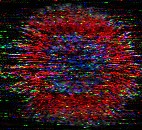
|
-webstream-
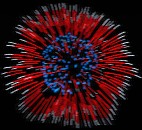 |
Please report decode to
themightykbc@gmail.com
██╗ ██╗ ██████╗ █████╗ ██████╗ █████╗ ██████╗ ██╗ ██████╗ ██████╗ ██████╗ █████╗ ███╗ ███╗
██║ ██║██╔═══██╗██╔══██╗ ██╔══██╗██╔══██╗██╔══██╗██║██╔═══██╗██╔════╝ ██╔══██╗██╔══██╗████╗ ████║
██║ ██║██║ ██║███████║ ██████╔╝███████║██║ ██║██║██║ ██║██║ ███╗██████╔╝███████║██╔████╔██║
╚██╗ ██╔╝██║ ██║██╔══██║ ██╔══██╗██╔══██║██║ ██║██║██║ ██║██║ ██║██╔══██╗██╔══██║██║╚██╔╝██║
╚████╔╝ ╚██████╔╝██║ ██║ ██║ ██║██║ ██║██████╔╝██║╚██████╔╝╚██████╔╝██║ ██║██║ ██║██║ ╚═╝ ██║
╚═══╝ ╚═════╝ ╚═╝ ╚═╝ ╚═╝ ╚═╝╚═╝ ╚═╝╚═════╝ ╚═╝ ╚═════╝ ╚═════╝ ╚═╝ ╚═╝╚═╝ ╚═╝╚═╝ ╚═╝
http://voaradiogram.net/
RSID: <<2016-07-02T16:01Z
MFSK-32 @ 17580000+1500>>
Welcome to program 170 of VOA Radiogram from the Voice of
America.
I'm Kim Andrew Elliott in Washington.
Here is the lineup for today's program, all in MFSK32, except
where noted:
1:20 Program preview (now)
2:37 Bamboo as a building material*
8:09 Juno spacecraft nears orbit around Jupiter*
15:12 Olivia 32-2000 at 2000 Hz: Neptune vortex*
21:20 MFSK32: Image and closing announcements*
* with image
Please send reception reports to radiogram@voanews.com.
And visit voaradiogram.net.
Twitter: @VOARadiogram
VOA NEWS
Scientists Test Bamboo as Building Material
George Putic, KI4FNF
June 27, 2016
Bamboo is not just for pandas anymore. One of the most
sustainable natural materials may finally be on track to be
accepted as a building material in the developed world.
Building codes everywhere require strict standardization of tests
for all materials, such as timber or concrete. But tests for
bamboo have not been standardized, because it's not manufactured,
but grown. So scientists at the University of Pittsburgh are
testing several varieties of bamboo with mechanical properties
that approach and even surpass those of softwood lumber. Their
aim is to standardize the tests so that bamboo can be safely used
in buildings.
Types of bamboo that have excellent strength-to-weight ratio grow
mostly in tropical regions where they have been used in building
for thousands of years.
The strength of at least three species is comparable to steel.
Uses range from scaffolding and support columns to walls and
floors. Bamboo can even be forced to grow in certain structural
shapes, such as arches.
But construction companies in other regions use bamboo mostly in
engineered form, as plywood and other laminated byproducts.
Professor Kent Harries, who is leading the research, says the
developed world should overcome the view that bamboo is a poor
man’s construction material.
"If we standardize it, if we provide essentially documentation
for test methods which the engineers can hang their hat on, I
don't like the word legitimize, but we bring the material into
the mainstream," he said.
Bamboo is remarkably strong and resilient, can grow up to 20
meters tall and can support heavy loads. Its harvest cycle is
only about three years compared to softwood, which requires about
10 years, and hardwood, more than 30 years.
http://www.voanews.com/content/scientists-test-bamboo-as-building-material/3394908.html
Image: A living space constructed of bamboo ...
Sending Pic:245x184C;

This is VOA Radiogram from the Voice of America.
Please send reception reports to radiogram@voanews.com.
VOA NEWS
NASA Juno Spacecraft, Nearing Jupiter, to Shed Light on Gas Giant
Mike O'Sullivan
June 26, 2016
PASADENA, CALIFORNIA - After a five-year journey, the spacecraft
Juno is nearing its destination, the planet Jupiter, where it
will enter polar orbit and start sending back data back July 4.
Scientists at Jet Propulsion Laboratory, the California mission
control center for this NASA project, say Juno will pierce the
dense clouds of the gas-covered giant and offer insights into its
origin and nature of both the planet and our solar system.
Launched in August, 2011 from Cape Canaveral, Florida, Juno is
powered by giant solar panels and will map the entire surface of
Jupiter during 37 orbits over 20 months, revealing information on
the planet's origin, structure, atmosphere and magnetic forces.
The craft will endure a harsh environment, says project scientist
Steve Levin. "Jupiter is the biggest, baddest planet in the
solar system," he said, with "a bigger magnetic field, bigger
aurora, bigger radiation belts, bigger gravity. Everything about
it really is bigger."
Radiation from the planet is intense, requiring a 170-kilogram
radiation vault, which Levin says is "a huge titanium box" to
shield the sensitive instruments.
The craft is like an armored tank, said principal investigator
Scott Bolton, "and we're diving in from above, trying to thread
the needle between the radiation belts and Jupiter's atmosphere."
Mini solar system
That atmosphere is made up mostly hydrogen and helium, like the
sun, and scientists say that beneath the visible clouds lies an
ocean of compressed liquid hydrogen. They do not know where
Jupiter has a solid core, but say that learning more about the
atmospheric composition, including its levels of water, will
offer important insights on the planet.
They say Jupiter is a kind of miniature solar system, circled by
four large moons and dozens of smaller ones, and that learning
more about it will help us understand planetary systems.
People around the world can follow the mission online by
downloading software called Eyes on the Solar System from the
NASA website.
On the night of July 4, California time, Kevin Hussey of NASA's
educational outreach team says "you're going to be able to
witness this historic event, the Juno spacecraft being captured
by Jupiter into orbit." In the months that follow, the public
can follow the mission's progress. In February, 2018, the Juno
craft will plunge into the Jovian atmosphere to burn up like a
meteorite, its mission completed.
The Juno mission is named for a goddess, who, in Roman mythology,
could see through clouds to learn what her husband, the god
Jupiter, was up to. Scientists say the spacecraft will, in a
similar way, reveal the mysteries of the planet Jupiter.
http://www.voanews.com/content/nasa-juno-jupiter/3392909.html
Image: Screen capture from video version of this VOA News story
...
Sending Pic:252x152C;
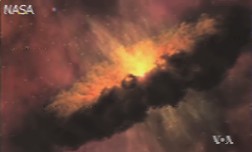
VOA Radiogram now changes to Olivia 32-2000 centered on 2000 Hz
...
RSID: <<2016-07-02T16:15Z
OL 32-1K @ 17580000+2000>>
This is VOA Radiogram in Olivia 32-1000.
'Dark Vortex' Spotted on Neptune
VOA News
June 24, 2016
Astronomers have spotted a "dark vortex" swirling in Neptune's
atmosphere.
Using high resolution images captured in May by the Hubble Space
Telescope, researchers say the vortex is about the size of the
continental United States.
The vortex is a high pressure system and is accompanied by bright
clouds. In 2015, astronomers spotted clouds and later a dark spot
nearby. The May 2016 images confirmed the presence of the vortex.
Vortices on Neptune have been spotted before. In 1989, the
Voyager 2 spacecraft saw one, and in 1994, Hubble pinpointed one.
They have relatively short lifespans compared to anticyclones
seen on Jupiter, which evolve over decades.
Full text:
bit.ly/28YkXYK
Returning to MFSK32 at 1500
Hz ...
RSID: <<2016-07-02T16:21Z
MFSK-32 @ 17580000+1500>>
This is VOA Radiogram in MFSK32.
Please send reception reports to radiogram@voanews.com.
Image: The vortex on Neptune as spotted by the Hubble telescope
...
Sending Pic:194x185C;
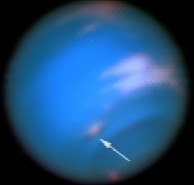
Please send reception reports to radiogram@voanews.com.
And visit voaradiogram.net.
Twitter: @VOARadiogram
Thanks to colleagues at the Edward R. Murrow shortwave
transmitting station in North Carolina.
I'm Kim Elliott. Please join us for the next VOA Radiogram.
This is VOA, the Voice of America.
Monday is Independence Day here in the United States.
Fireworks will be displayed here in Washington DC and throughout
the country ...
Sending Pic:308x213C;

+
closing title (lyrics):
Yankee Doodle:
Yankee Doodle went to town
a-riding on a pony,
Stuck a feather in his
hat
And called it macaroni.
Yankee Doodle keep it
up,
Yankee Doodle dandy,
mind
the music and the step,
and with the girls be
handy.
My father
and I went down to camp
along with
Captian
Gooding,
and there we saw the men and boys
as thick as hasty
pudding.
Yankee Doodle keep it up,
Yankee Doodle dandy,
mind
the music and the step,
and with the girls be handy.
And there was General Washington
upon
the slapping stallion
giving orders to his men
I guess there was a million. . . .
www.rhci-online.net/radiogram/radiogram.htm









